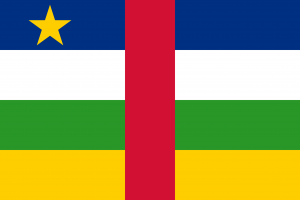Language/Sango/Grammar/Adjectives
Hi Sango learners! 😊
In this lesson, we will dive into the use of adjectives in Sango. Adjectives are essential in any language as they give more detail and context to nouns. Let's get started!
Once you've mastered this lesson, take a look at these related pages: Pronouns, How to Use Be & Plurals.
What is an adjective?
In Sango, an adjective is a word that describes or modifies a noun or pronoun by providing more information about it. Adjectives usually come before the noun they modify. For example:
| Sango | Pronunciation | English |
|---|---|---|
| mbɔti | [mbɔ̀tì] | big |
| kəre | [kərè] | small |
| nyele | [ɲɛ̀lɛ̀] | pretty |
Adjective agreement
One interesting thing to note about adjectives in Sango is that they agree with the noun they modify in gender and number. If the noun is singular, the adjective has to be singular, and if the noun is plural, the adjective also has to be plural. If the noun is feminine, the adjective has to be feminine, and if the noun is masculine, the adjective has to be masculine. Here's an example:
| Sango | Pronunciation | English |
|---|---|---|
| ngaba mɔdara | [ŋàgbà mɔ̀dàrà] | black car |
| ngaba nɛne | [ŋàgbà nɛ́nɛ́] | black house |
| mbɔti mɔdara | [mbɔ̀tì mɔ̀dàrà] | big car |
| mbɔti nɛne | [mbɔ̀tì nɛ́nɛ́] | big house |
In the examples above, notice how the adjective "ngaba" (black) changes to "mbɔti" (big) when the noun changes from "car" to "house". In addition, "mɔdara" and "nɛne" are both singular, but the adjective for "car" has a different ending from the one for "house". This is because "mɔdara" is masculine, while "nɛne" is feminine.
Comparative and superlative forms
In Sango, the comparative and superlative forms of adjectives are formed by adding the words "pɛ" and "na pɛ" respectively before the adjective. For example:
| Sango | Pronunciation | English |
|---|---|---|
| mbɔti | [mbɔ̀tì] | big |
| mbɔti pɛ | [mbɔ̀tì pɛ́] | bigger |
| mbɔti na pɛ | [mbɔ̀tì nà pɛ́] | biggest |
In the dialogue below, you can see how the comparative form is used.
- Person 1: Bató ya bayòbé́ *(This car is fast)*
- Person 2: Àʒò mbɔti pɛ́ *(But my car is bigger)*
- Person 1: Ah, ŋgà ngbatɛ́ pà *(Ah, so yours is the biggest)*
Positioning of adjectives
In Sango, adjectives almost always come before the noun they modify, but there are exceptions. For example, when an adjective is used to specify a unique characteristic of a noun, it comes after the noun. Here's an example:
| Sango | Pronunciation | English |
|---|---|---|
| kaja ti-yo | [kàjà tì-yò] | mother her-food |
| ti-yo kaja | [tì-yò kàjà] | food her-mother |
In the examples above, "kaja ti-yo" means "her mother's food", while "ti-yo kaja" means "food made by her mother".
Practice
To practice using adjectives in Sango, try describing the people around you. Here are some adjectives to get you started:
| Sango | Pronunciation | English |
|---|---|---|
| mbiya | [mbìyà] | tall |
| nyele | [ɲɛ̀lɛ̀] | pretty |
| kəre | [kərè] | small |
| ndara | [̀ndàrà] | handsome |
Use the adjective agreement we learned earlier to make sure you match the gender and number of the adjective to the noun you are describing!
Conclusion
Congratulations! You have learned a lot about adjectives in Sango. To improve your Sango Grammar, you can also use the Polyglot Club website. Find native speakers and ask them any questions! You can also check out our other grammar lessons if you want to keep learning. 😊
➡ If you have any questions, please ask them in the comments section below.
➡ Feel free to edit this wiki page if you think it can be improved. 😎
Finished this lesson? Check out these related lessons: Questions & Future Tense.
Other Lessons
- Conditional Mood
- How to Use Have
- Give your Opinion
- How to Use Be
- Questions
- Pronouns
- Future Tense
- Negation
- Plurals
Sources
- Language Sango - APiCS Online
- AGRAMMAR OF SANGO William J. Samarin, Ph.D. Assistant ...
- Sango language - Wikipedia

